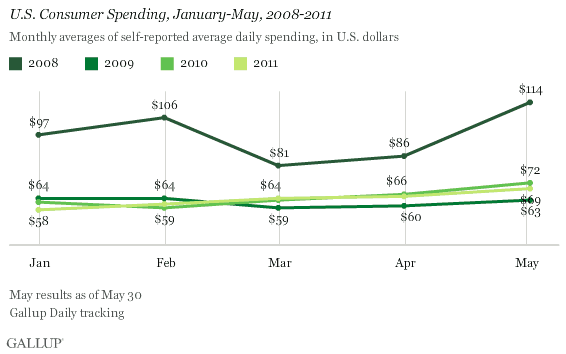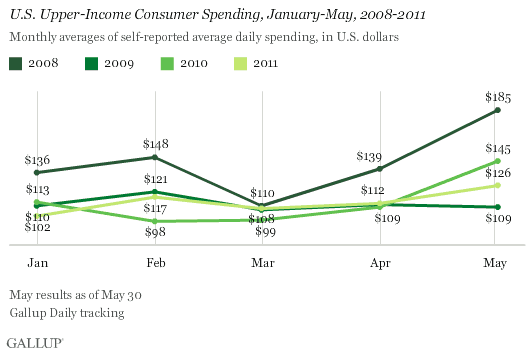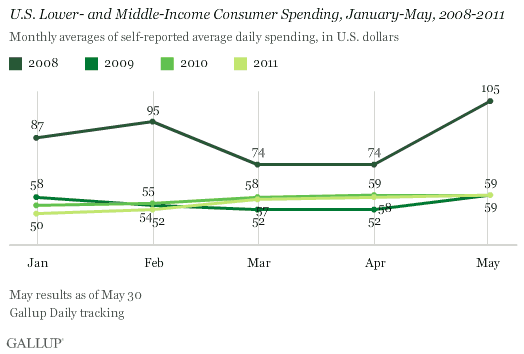PRINCETON, NJ -- Overall self-reported daily consumer spending in U.S. stores, restaurants, gas stations, and online averaged $69 per day during May -- up from $65 in April, but not as good as the $72 average of May 2010.

Consumer spending over the first five months of 2011 has followed a pattern similar to that of 2010. Spending in both years has been far below that of 2008.
Upper-Income Americans Spent Less This May Than Last
Upper-income spending (among Americans making $90,000 or more annually) averaged $126 per day in May, down from the $145 of the same period in 2010. While these Americans have the disposable income to spend more freely when they choose, they continue to hold back. Upper-income spending during the first five months of 2011 has been highly consistent with that of 2010.

Lower- and Middle-Income Spending Continues in New Normal
Lower- and middle-income Americans' self-reported spending averaged $59 per day during May -- essentially the same as during the prior two months. These Americans, who make less than $90,000 a year, have so far in 2011 spent at levels similar to those of 2010.

Implications
Despite the surge in economic confidence Gallup measured after Osama bin Laden's death and the benefit of two weeks of modest declines in gas prices, U.S. consumers are spending no more in 2011 than they did in 2010. Upper-income consumers in particular seem to have pulled back on their spending, erasing any thought of the "frugality fatigue" seen in May of last year.
This finding is consistent with other economic data suggesting the U.S. economy is experiencing a so-called soft patch. The Chicago Institute for Supply Management report released Tuesday shows a slowdown in manufacturing, and the Case-Shiller Index reports lower year-over-year home prices -- implying housing may not have reached bottom. It is little wonder that many economists are lowering their forecasts for the economy in 2011.
The question going forward is whether the current slowdown is simply transitory, as suggested by Federal Reserve Board Chairman Ben Bernanke, or something indicative of economic stagnation or stagflation. At this point, the answer is unclear.
Gallup.com reports results from these indexes in daily, weekly, and monthly averages and in Gallup.com stories. Complete trend data are always available to view and export in the following charts:
Daily: Employment, Economic Confidence and Job Creation, Consumer Spending
Weekly: Employment, Economic Confidence, Job Creation, Consumer Spending
Read more about Gallup's economic measures.
View our economic release schedule.
Survey Methods
Results are based on telephone interviews conducted May 1-30, 2011, on the Gallup Daily tracking survey. Interviews were conducted with a random sample of 14,011 adults, aged 18 and older, living in all 50 U.S. states and the District of Columbia.
For results based on the total sample of national adults, one can say with 95% confidence that the maximum margin of sampling error is ±1 percentage point.
Interviews are conducted with respondents on landline telephones and cellular phones, with interviews conducted in Spanish for respondents who are primarily Spanish-speaking. Each sample includes a minimum quota of 400 cell phone respondents and 600 landline respondents per 1,000 national adults, with additional minimum quotas among landline respondents for gender within region. Landline telephone numbers are chosen at random among listed telephone numbers. Cell phone numbers are selected using random-digit-dial methods. Landline respondents are chosen at random within each household on the basis of which member had the most recent birthday.
Samples are weighted by gender, age, race, Hispanic ethnicity, education, region, adults in the household, and phone status (cell phone only/landline only/both, cell phone mostly, and having an unlisted landline number). Demographic weighting targets are based on the March 2010 Current Population Survey figures for the aged 18 and older non-institutionalized population living in U.S. telephone households. All reported margins of sampling error include the computed design effects for weighting and sample design.
In addition to sampling error, question wording and practical difficulties in conducting surveys can introduce error or bias into the findings of public opinion polls.
For more details on Gallup's polling methodology, visit www.gallup.com.
